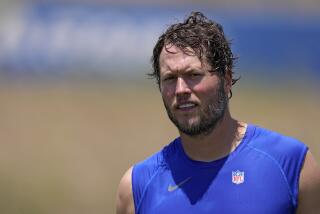Scientists study surge in heat-related football deaths
- Share via
The risk of heat-related illnesses for high school football players is higher than ever due to record temperatures around the country and the fact that football players these days are bigger than ever, experts from the Union of Concerned Scientists said last week.
The combination has been fatal for three high school players and one coach just in the last 10 days. A Dallas coach with a heart condition died last Monday after conducting practice in 100-degree heat. The very next day, two Georgia players, both 16, died from heat exhaustion — one had been hospitalized for a week after collapsing, and the other collapsed and died at a high school football camp. On July 30, a 14-year-old boy in South Carolina died during a morning workout on a 101-degree day.
In addition, the death of a South Florida football player on July 26 is suspected to be heat-related.
The death rate during football practice was about one per year from 1980 to 1994, but it has roughly tripled since then to 2.8 deaths per year, according to climatologist Andrew Grundstein of the University of Georgia.
Grundstein studied 58 fatalities since 1980 in detail and found that most of the deaths were among kids younger than 18. Most were in the Eastern U.S. and occurred during the first few days or weeks of practice. The majority of fatalities were among athletes who were overweight or obese — usually linemen.
The study included 33 deaths for which complete weather information was available. In all of those cases, the combination of temperature, humidity and solar radiation was extremely high, Grundstein said.
“High humidity levels can make conditions very oppressive and very stressful,” he said. “I think that explains a lot of the deaths we’re seeing.”
Climate change appears to be a factor. Summer temperatures this year have been among the warmest on record in many U.S. cities, said Deke Arndt, chief of the Climate Monitoring Branch of the National Oceanic and Atmospheric Assn.’s National Climatic Data Center.
In July, 78 U.S. locations recorded all-time temperature highs and 213 locations set records for the warmest low temperatures during the night. “The temperature around sunrise is the warmest it has ever been,” he said.
That means that holding practice early in the morning isn’t enough to protect players from heat-related illnesses, such as muscle cramping, dehydration, heat exhaustion and exertional heat stroke, Grundstein said. In his study, 60% of the deaths occurred in the morning.
“I think [coaches and players] just need to keep their guard up,” he said.
The American College of Sports Medicine and the National Athletic Trainers Assn. have published guidelines for safe practice in hot weather, which include close monitoring of at-risk athletes, such as overweight youths or kids who have been ill recently.
On Monday the American Academy of Pediatrics is scheduled to release its recommendations on heat-related illness risk and physical activity in children. The document calls for all youth sports programs to develop a detailed strategy to prevent heat illness.
In a change from its previous policy, the academy now says that children are able to tolerate and adapt to exercise in heat as well as similarly fit adults. The new policy does not give specific rules about when games and practices should be canceled, but it notes that coaches should recognize that individual children will differ in their ability to handle exercise in hot weather.
Colleges don’t allow football teams to train twice a day during the first week of practice, but this is still common among high schools. In addition, high school players often begin practice dehydrated and aren’t always well rested, the researchers said. They may condition only during football season and show up for the first practices out of shape, then face pressure from their peers or coaches to do more, said Dr. Michael Bergeron, a professor in the department of pediatrics at the University of South Dakota and director of the National Institute for Athletic Health and Performance.
The body needs up to 14 days of progressive activity in heat to acclimate to the conditions, according to the American College of Sports Medicine.
Coaches need to assess climate conditions like morning temperature and humidity, call plenty of breaks, practice the players without full gear and know the signs and symptoms of heat-related illness, Bergeron said. They also should have an emergency-response plan that includes a cooling tub, a way to move a stricken player from the practice field and a safety plan that includes a clear path for an ambulance.
“Clearly, there needs to be better monitoring,” he said. “All of these heat exertion deaths are preventable.”
More to Read
Sign up for The Wild
We’ll help you find the best places to hike, bike and run, as well as the perfect silent spots for meditation and yoga.
You may occasionally receive promotional content from the Los Angeles Times.








